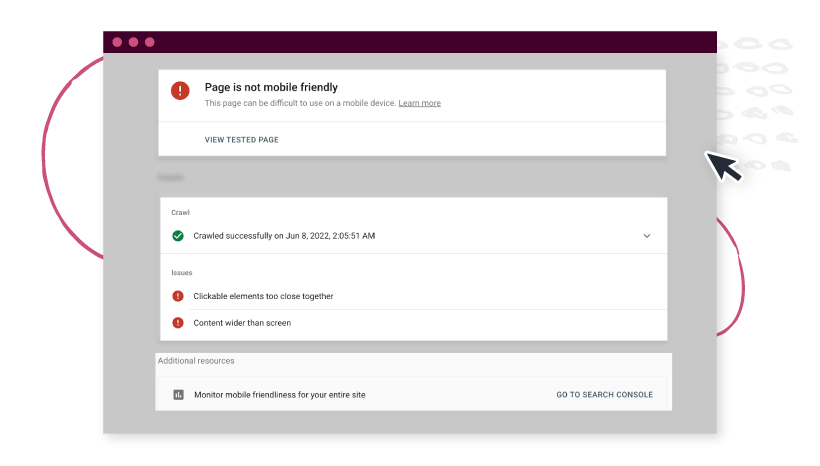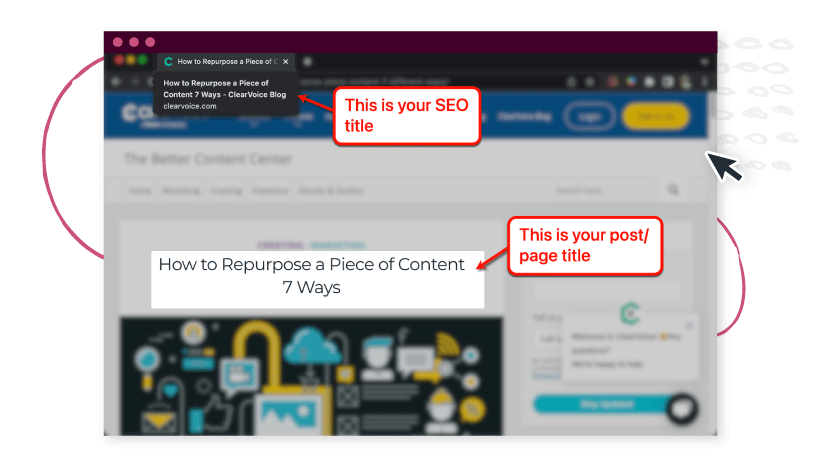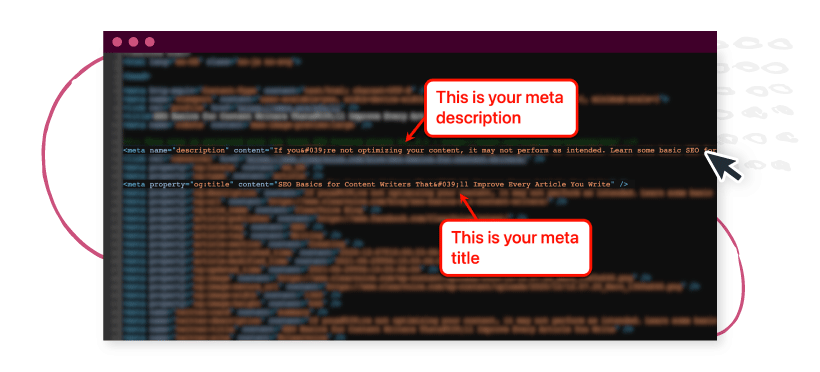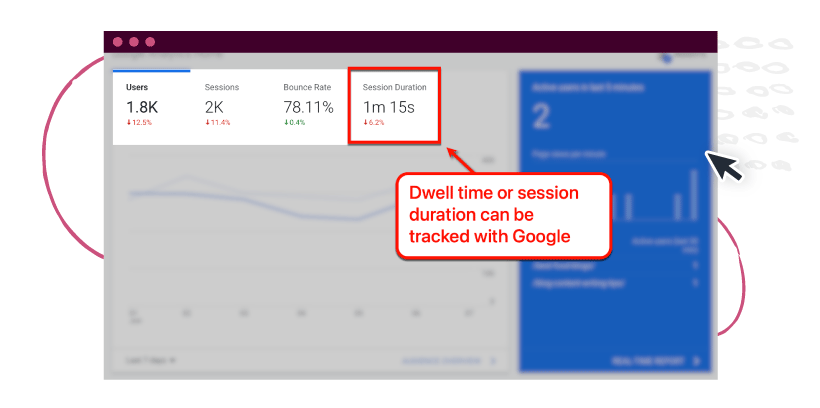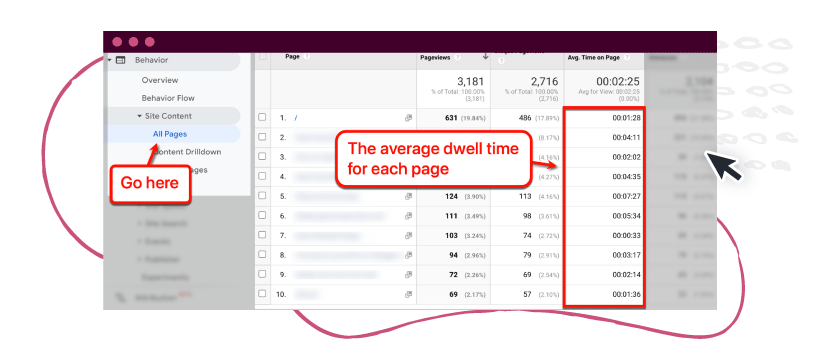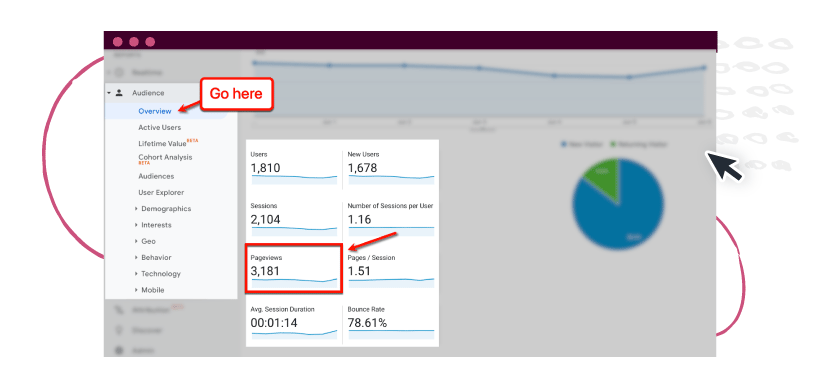Can dwell time, page views, and user engagement affect your Google rankings? Or should you put them on the back burner and focus on content and link building?
Learn what these terms above are, if they even matter to SEO, and how to improve them when writing content. Some may not directly affect search engine rankings, but they have a strong influence on a website’s overall SEO performance.

User engagement metrics
Several metrics tied to user engagement rates can lead to higher rankings and more organic traffic. Not all of them, however, are officially recognized by Google as ranking factors, but that doesn’t mean they’re not important for SEO.
1. Mobile optimization
Google’s “Mobile-first indexing” initiative means the search engine will look at a page’s mobile version first when determining rankings.
If your page isn’t optimized for mobile users, your chances of snagging a high position in search results are slim.
There are many ways to improve the mobile experience on your website, like being mindful of your image sizes and ensuring your web elements aren’t overwhelming to your site visitors. To pinpoint urgent issues as well as reveal remediation suggestions, use a tool like Mobile-Friendly Test.
This free tool from Google evaluates a website’s mobile performance and provides recommendations, along with links to helpful resources.
Image Source: Search.Google.com
2. Links (inbound, outbound, and internal)
There’s a reason why link building is the go-to strategy of SEO specialists.
Backlinks from authoritative sites, in particular, are a crucial ranking factor Google uses to measure relevance, quality, and trustworthiness. But that’s just one side of the coin.
Other link types, including outbound links and internal links, also matter for SEO.
- Outbound links: Links on your web pages that point to other websites. Using outbound links in itself is not a ranking factor. But it can significantly enhance the user experience and help Google understand what your content is about.
- Internal links: Links from your page that point to another page within your own domain. They help your visitors see more of your website, leading to more pages per session. More importantly, they help spread link equity or “link juice,” which can lift the overall rank-worthiness of your website.
3. Meta tags
Specific meta tags can affect both your rankings and organic traffic.
The title tag, for example, is a ranking factor that Google uses to identify the content’s topic. (Note that this is different from the post title.)
While the post title appears within the content itself, the title tag or “SEO title” appears in the browser tab where the content is loaded.
To optimize the title tag, keep it short. The general consensus is 50 to 60 characters. Also, be sure to include your primary keywords — preferably at the beginning of the title. You can easily configure title tags using SEO plugins like Yoast.
The meta description is another meta tag that can affect organic traffic. It refers to the snippet of text that appears below the title in search engine results. The ideal length for meta tags is 155 to 160 characters.
Just like the title tag, you can use Yoast to customize your content’s meta description. Alternatively, you can modify these meta tags via HTML.
While a meta description is not exactly a ranking factor, it allows you to get the attention of search engine users and win more clicks.
4. Bounce rate
Google has stated time and time again that bounce rate is not a ranking factor. However, bounce rate as a metric offers a reliable way to gauge the effectiveness of your content strategy.
Bounce rate measures the likelihood of single-page sessions, which occur when a user immediately leaves a site after viewing one page.
Ideally, you want users to have a more productive click path through your website. You need them to see more of your website by viewing more pages and possibly taking action.
You can also use bounce rate as a warning sign for factors that negatively impact rankings, such as:
- Page loading speed
- Poor content quality
- Too many ads
- Poor mobile optimization
With these engagement-related factors out of the way, let’s turn to the ones that are most disputed: dwell time and page views.
Dwell time may not be officially recognized by Google as a ranking factor, but SEO experts have proven a strong correlation between this metric and high search engine rankings.
Dwell time, also referred to as “session duration” and “time on site,” is a metric tied to content quality. It measures the average amount of time users spend reading or dwelling on a page.
The better the content quality, the longer users will stick around.
How can you measure dwell time?
Dwell time can be manually calculated by adding the duration of all website visits and dividing it by the number of sessions. But you can use tools like Google Analytics to get the raw figure. In fact, it’s one of the metrics shown on the dashboard upon logging in.
Image Source: Analytics.Google.com
To measure dwell time on a page level, go to ‘Behavior,’ expand ‘Site Content,’ and click ‘All pages.’ Here, you can track the average time visitors spend on each page — starting with the top pages.
Image Source: Analytics.Google.com
Dwell time SEO tips
To increase dwell time, influence your site visitors to stay for as long as possible. Here are some of the best ways to do it:
- Spice up content with visuals: Thick, intimidating walls of text can put off readers and make them leave without reading the entire post. As a rule of thumb, insert high-quality visuals — preferably one for every 300 words — to captivate readers.
- Make your content more skimmable: Statistics show that 73 percent of readers skim posts rather than consume content thoroughly. Content marketers can cater to this type of reader by incorporating an adequate number of headers and subheaders to lock their attention.
- Add internal links to relevant pages: Sometimes, readers leave a site simply because they have nowhere else to go — resulting in a session duration of 0 seconds. This can be mitigated by inserting internal links to related pages that add value to the page experience.
- Insert a clickable table of contents: A clickable table of contents helps readers find exactly what they’re looking for from the jump. This is especially helpful if your content is over 1,000 words and your site visitors might get frustrated trying to look for the information they need.
- Use an exit-intent pop-up: An exit-intent pop-up works by presenting readers a special offer as soon as they try to navigate away from your site. It has to be relevant to the topic covered in the post, otherwise, the pop-up will only be disruptive.
Page views
Page views or “pageview hit,” refers to the number of times users access a page. This includes the times a page is reloaded even by the same user. Page views indicate page popularity. It can also be used to gauge the effectiveness of your SEO tactics.
However, page views as a ranking factor is a long-debunked SEO myth. While page views don’t directly affect search rankings, it impacts other user engagement factors that determine a page’s position in search.
How can you measure page views?
Similar to dwell time, page views can be tracked using Google Analytics. Just head to your dashboard and click ‘Audience.’ Your average monthly page views should be visible on the overview page.
Image Source: Analytics.Google.com
Page views can also be tracked on a per-page basis using Google Analytics. Alternatively, marketing platforms like Semrush and Ahrefs can reveal the individual traffic performance of pages in detail.
Page view tips
Getting more page views can be seen as either the starting point or end goal of SEO.
As such, implementing a solid SEO content strategy is one of the keys to getting more page views. This includes:
- Optimizing content for long-tail keywords
- Mentioning authoritative sources
- Using the correct markups for post types
Other than content optimization, here are a few ways to ramp up your page views:
- Promote content on social media: Sharing content on social media helps you generate instant traffic and exposure. Repurpose content based on the preferences of social media users to higher click-through rates.
- Share content with online communities: Community-driven websites like Reddit can be an excellent traffic source, even for fresh content. You only need to find the right community, engage posts that are relevant to your content’s topic, and provide a link to attract potential readers.
- Use email marketing: You can build an email list and send regular messages that funnel traffic to your posts. A key advantage of email marketing over other strategies is that you’re promoting to audiences who are already familiar with your brand.
Google rankings: FAQs
1. What is SEO ranking?
SEO ranking refers to a web page’s position in SERPs or search engine results pages. The higher your SEO rankings, the more organic traffic you can generate from search engines.
2. How can I improve my SEO ranking?
There are a handful of proven strategies to boost your website’s SEO ranking:
- Write high-quality content
- Improve page loading speed
- Build backlinks from authoritative sites
- Insert internal links within posts
- Optimize your content for mobile users
- Research and incorporate the right keywords into your content
- Build a strong social media presence
3. How does Google search ranking work?
Search engines like Google rank web pages based on a variety of factors, like page experience, mobile-friendliness, and content quality. Rankings help search engine users find the best piece of content out of billions of results.
Top-notch content and SEO go hand in hand.
It takes more than a talented writer to produce content that will rank well in search results. To secure higher rankings, you need technical SEO knowledge and a fine-tuned SEO content strategy.
ClearVoice’s network of content experts can help you with both. Use the form below and start creating SEO-friendly content for your online brand.
